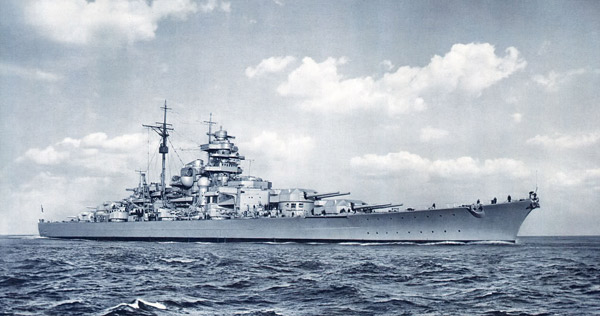Bismarck-class
Summary
| Origin country | 🇩🇪 Germany |
| Category | Battleship |
| Subtype | Battleship (World War II) |
| Manufacturer | Blohm + Voss |
| Year commissioned | 1940 |
Description
The Bismarck class consisted of two fast battleships, Bismarck and Tirpitz, built for Nazi Germany's Kriegsmarine before World War II. As the largest and most powerful warships for the Kriegsmarine, they displaced over 41,000 metric tons and were armed with eight 38 cm guns, boasting a top speed of 30 knots. The ships were a reaction to French Richelieu-class battleships and embodied a confused strategic vision of the German Navy in the 1930s, being intended for both traditional battleship engagements and long-range commerce raiding.
Bismarck was constructed between July 1936 and September 1940, while Tirpitz's keel was laid in October 1936, with the work completed by February 1941. Their operational careers were brief; Bismarck engaged in Operation Rheinübung in the North Atlantic, where it destroyed HMS Hood and damaged Prince of Wales in the Battle of the Denmark Strait. However, Bismarck was subsequently sunk after a three-day chase. Tirpitz acted as a fleet in being in Norwegian waters, threatening British-Soviet convoys. Repeated attacks by the Royal Navy and Royal Air Force left Tirpitz largely unharmed until 1944 when a successful bombing raid with Tallboy bombs caused extensive internal damage and capsized the ship.
The design process for the Bismarck class began in 1932, leading to a final design that favored heavy armor and armament at the cost of exceeding displacement limitations set by international treaties. Strategic design choices included a three-shaft propulsion system and a focus on close-range combat. However, the ships were tactically mismatched to their actual use as commerce raiders, as their intended engineering didn't support such roles due to limited cruising ranges.
Bismarck and Tirpitz differed in several aspects, from funnel caps and crane placements to their degaussing coils and configurations of hangers. They shared a three-shaft arrangement with geared turbine engines, powered by twelve boilers. Bismarck reached a top speed of 30.01 knots on sea trials, whereas Tirpitz managed 30.8 knots due in part to increased horsepower. Respective fuel capacities allowed for significant operational ranges at 19 knots.
The main battery of both ships had four twin-turret arrangements, allowing for a balanced armament distribution. The secondary battery comprised twelve 15 cm guns, and the ships were originally equipped with sixteen 10.5 cm anti-aircraft guns and multiple smaller caliber guns for close-in defense. Tirpitz was further equipped with quadruple 53.3 cm torpedo tubes.
Their armor layout included a thick belt, extensive deck armor, and well-protected main and secondary battery turrets, with some variation compared to their international contemporaries. Underwater protection was designed to resist significant explosive impacts.
Bismarck was built at the Blohm & Voss shipyard and launched with Hitler's attendance in February 1939. Extensive sea trials ensued before she joined the fleet. For Tirpitz, commissioned over a year after Bismarck, readiness took additional time; her construction at the Kriegsmarinewerft required innovation in terms of infrastructure due to her impressive size and tonnage. Both ships met their demise during the war, with Bismarck's sinking leading to significant loss of life. Tirpitz's wreck was eventually scrapped between 1948 and 1957.
Technical specifications
| Bismarck | |
|---|---|
| Displacement | 50900 tons |
| Range | 15000 km |
| Crew | 2065 members |
| Width | 36.0 m (118.1 ft) |
| Length | 241.6 m (792.7 ft) |
| Propulsion | 150,000 hp - 3 propellers |
| Armament | 8 380 mm guns + 12 150 mm guns + 16 105 mm guns + 16 37 mm guns + 12 20 mm guns. |
| Maximum speed | 30 knots |
Photo of Bismarck class
